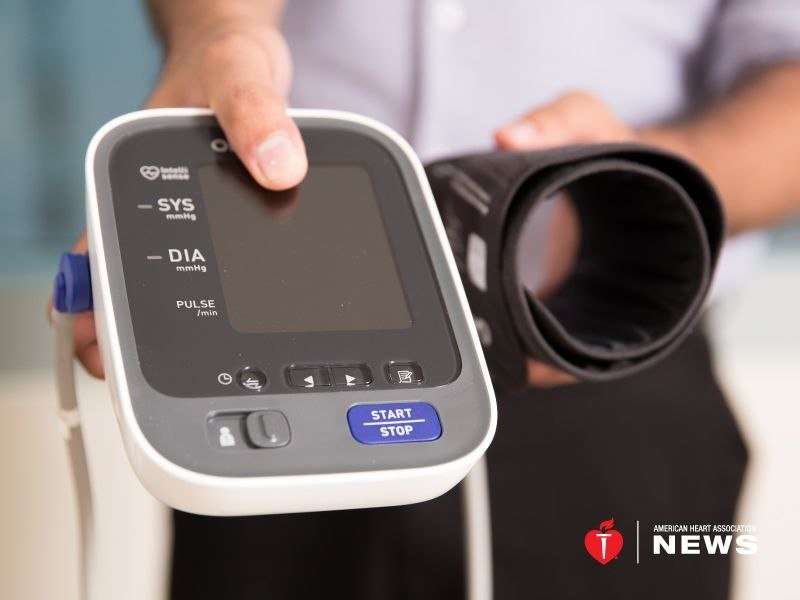Blood pressure measurement mistakes can lead to misdiagnoses

It's a familiar scenario: You find yourself at the doctor's office, sitting on the edge of an exam table with your feet dangling inches above the floor. The nurse or medical assistant who seconds ago instructed you to sit now asks you questions about the reason for your visit—all while taking your blood pressure.
That measurement, however, could come back dangerously high—and flat wrong.
Together, the dangling feet, the unsupported back, even the chit chat are more than enough to throw off a blood pressure reading and classify a patient as having high blood pressure when he or she doesn't.
And if that measurement was taken with the blood pressure cuff on top of a shirt sleeve instead of a bare arm? It could push a patient's reading high enough to qualify for medication that might not be needed.
Until recently, high blood pressure, or hypertension, was defined by any measurements with 140 or higher as the top number, and 90 or greater as the bottom.
Last November, the American Heart Association updated its high blood pressure guidelines and established a new threshold for diagnosing high blood pressure at 130/80. That change of 10 mmHg (millimeters of mercury) was enough to classify nearly half of all Americans as having high blood pressure.
It also has served as a reminder about the importance of getting blood pressure measured properly.
Yet, for a procedure performed millions of times every day across the country, very few medical professionals—even nurses and doctors—nail the routine correctly, said Dr. Michael Rakotz, a family physician and the vice president of health outcomes for the American Medical Association.
An ongoing AMA campaign has tried to raise awareness about how to correct the most common errors people make when measuring blood pressure, whether at the doctor's office or at home.
"Every time we go out and conduct blood pressure measurement trainings, people tell us afterward that they've been doing it wrong for years," Rakotz said.
Posters tacked inside exam rooms and vital stations are aimed just as much at patients as they are at clinical staff because "once the patients learn how their blood pressure should be measured, they aren't going to let anybody measure it incorrectly again," he said.
When getting blood pressure measured, both feet need to rest on the ground or a stool. The back needs to be supported, as well as the arm, which should be propped at heart level. Many times, these procedures fail to be observed.
Other common mistakes include:
- Failing to rest before a measurement. Sitting quietly for about five minutes can help relax the body.
- Placing a cuff over clothing. Depending on the thickness of the sleeve, clothing can add up to 50 mmHg to a reading. The blood pressure cuff needs to be placed on a bare arm—so roll up your sleeve or come wearing short sleeves.
- Using the wrong sized cuff. Squeezing an arm into a cuff that's too small can add anywhere between 2 mmHg and 10 mmHg to a measurement.
- Engaging in conversation. Avoid the small talk. Even active listening can add 10 mmHg.
With just one or two simple errors in measurement techniques, a patient could suddenly find himself classified as having high blood pressure, said Dr. Raymond Townsend, a nephrologist.
"Suddenly, they have a disease that they didn't have yesterday," said Townsend, director of the hypertension program at the University of Pennsylvania Hospital. "When you label someone as having hypertension, you actually have given them a chronic disease label. That can be a downer in our outlook on life so getting it right is important."
Townsend worked with Rakotz on a study where they implemented a "blood pressure check challenge" to nearly 160 medical students during the 2015 AMA annual meeting.
Only one student performed all 11 measurement elements correctly.
"It didn't matter if you were a guy or a gal, whether you were a first-year medical student or fourth-year, whether you were going into internal medicine or obstetrics. They just didn't know what they were doing," Townsend said. "Out of 11 possible things to do right, the average they got was four."
Townsend knows that doctors have a lot of information to balance in their minds when seeing patients.
"But of all the things that we do in clinical medicine, what is the single most important difference we can make to help someone live longer and live free of target organ damage? There's only one answer," he said. "It's to measure and treat blood pressure correctly."
Copyright is owned or held by the American Heart Association, Inc., and all rights are reserved. If you have questions or comments about this story, please email editor@heart.org.




















